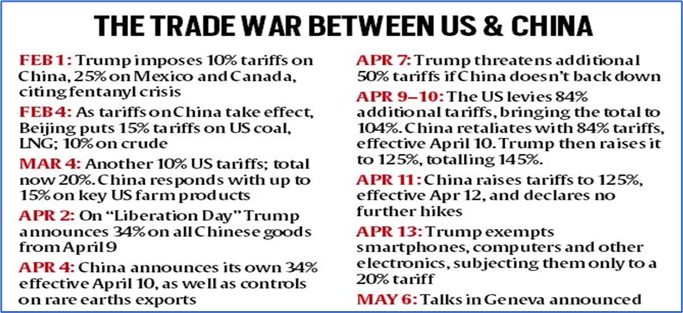Why in News?
The United States and China have agreed to a 90-day pause in their trade war following two days of high-level talks in Geneva.
Both countries will suspend the high tariffs and non-tariff barriers imposed since April 2. In a joint statement, they expressed commitment to resolving their trade disputes.
What’s in Today’s Article?
- Background - Tariffs Between the US and China
- Rationale Behind the Imposition of Tariffs
- Current US-China Trade Situation After the Truce
- Reasons Behind the US-China Trade Truce
- Conclusion
Background - Tariffs Between the US and China
- Since February 1, the US began imposing tariffs on China, initially citing the sale of fentanyl—an opioid linked to numerous overdose deaths in the US—as the reason.
- April 2 Tariff Hike – “Liberation Day”
- On April 2, designated by President Trump as “Liberation Day,” the US significantly increased tariffs, imposing an additional 34% on Chinese imports.
- China's Response
- China retaliated with its own set of counter-tariffs, a move that differed from most other countries' reactions.
- Further Escalation
- By April 10, tariffs had escalated to extreme levels:
- US tariffs on Chinese goods: 145%
- China's tariffs on US goods: 125%
- This meant a $100 Chinese product would cost $245 in the US after tariffs.
- Non-Tariff Measures by China
- Apart from tariffs, China implemented non-tariff barriers such as:
- Export restrictions on rare earth minerals
- Regulatory actions and investigations against several US companies

Rationale Behind the Imposition of Tariffs
- Concern Over Trade Deficit
- The US Trade Representative cited the $1.2 trillion trade deficit in goods as a primary reason.
- This figure reflects that US consumers import significantly more than what is exported to the rest of the world.
- Perception of Unfair Trade Practices
- The Trump administration views the trade deficit as a sign that the US is being ripped off by other countries, which:
- Protect their domestic companies
- Provide subsidies to help them outcompete American firms in the US market
- Rise in Trade Deficit Since 2020
- Experts noted that the trade deficit had grown by over 40% since the end of Trump’s first term, reinforcing the administration’s concern.
- Justification for Tariffs
- Past efforts such as negotiations and diplomatic requests to open foreign markets had failed.
- Hence, the administration viewed high tariffs as the most logical and necessary solution to protect US interests.
Current US-China Trade Situation After the Truce
- Reduction in Base Tariffs
- Following the truce, both countries have reduced their base tariff rates to 10% on each other’s imports.
- Additional US Tariff on Fentanyl
- The US still imposes an additional 20% tariff specifically due to fentanyl smuggling concerns.
- Effective US tariff on Chinese imports: 30%
- Effective Chinese tariff on US imports: 10%
- Suspension of Non-Tariff Barriers by China
- China has suspended all non-tariff barriers introduced after April 2, including export restrictions and company investigations.
Reasons Behind the US-China Trade Truce
- Tariffs Hurt Consumers More Than They Help
- While tariffs protect domestic producers, they raise prices for all consumers, making them a counterproductive tool for addressing trade imbalances.
- The economic pain on consumers is widely spread, while the benefit to producers is narrowly concentrated — creating a misleading perception of overall benefit.
- Rising Prices and Economic Strain
- Tariffs made all imports more expensive, increasing the cost of living and squeezing household budgets.
- This led to price pressure across the US economy, including retail giants like Walmart, where the risk of empty shelves became real.
- Economic Contraction and Recession Risk
- The US economy contracted in the first quarter of 2025, even before the full impact of the tariffs could be felt.
- Economists widely predicted a recession, defined as two consecutive quarters of negative GDP growth.
- Threat of Stagflation
- With rising prices due to tariffs and a slowing economy, the US was increasingly at risk of stagflation—a dangerous mix of economic stagnation and high inflation.
Conclusion
Despite the positive sentiment, this is not a final trade agreement. It is merely a 90-day truce to begin negotiations and de-escalate tensions. There is no clarity on who initiated the Geneva talks, suggesting that deep mistrust remains. The upcoming negotiations are expected to be complex, tense, and potentially difficult, with no guaranteed outcome.










